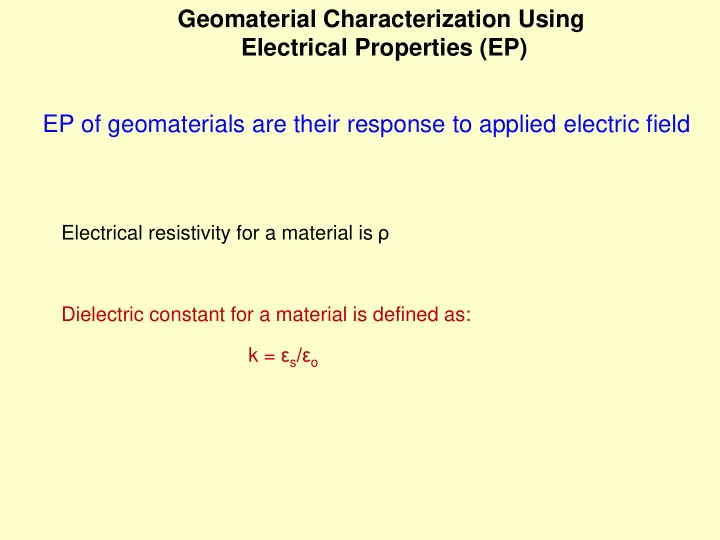

Geomaterial Characterization Using Electrical Properties (EP) EP of geomaterials are their response to applied electric field Electrical resistivity for a material is ρ Dielectric constant for a material is defined as: k = ε s / ε o
Geomaterial Characterization Using Electrical Properties Electrical Resistivity ( ) Dielectric constant (k) METHODS • Low frequency resistivity methods (<100 Hz) • High frequency dielectric methods (10 4 -10 9 Hz) ADVANTAGES OVER OTHER METHODS: • Non destructive • Fast and easy • Incorporate response of the micro-structure (of the soil mass)
Parameters influencing Electrical Properties of Geomaterials • Porosity and the pore structure • Water content • Salinity level • Cation exchange capacity of the soil • Temperature • Type and Frequency of the current Parameters influencing Liquefaction of soils • Grain shape and size • Porosity & Relative Density • Variation of Water table • External Forces/Disturbances---shearing • Resistivity = f (void ratio)=f (density) • Change in resistivity= f (change in the void ratio) = f (change in the density)
METHODS FOR LABORATORY MEASUREMENT OF SOIL RESISTIVITY Two-electrode method Power supply Voltage Measurement SAMPLE Electrode Electrode
Four-electrode method ~ Power supply V SAMPLE Electrode
Electrical Resistivity Box (100 mm cube) Plate electrode V A I L A R L Plate electrode = resistivity R= resistance Electrode point A = Area of electrodes L = spacing between the electrodes
ELECTRICAL RESISTIVITY BOX (TWO-ELECTRODE METHOD) 12 cm Point Electrodes @ 12 cm 3 cm It is difficult to determine A A R L 12 cm R . a a: shape factor for the electrode
ELECTRICAL RESISTIVITY PROBE Top nut 1 2 23 4 3 55 mm Lock nut 32 Ebonite ring Copper electrode 25 25 95 mm 25 20 SS pointed tip 16
Generalized relationship for Determining Soil Electrical Resistivity = A e (-(Sr-5)/B) Relationship between Electrical Resistivity and Thermal Resistivity Log ( ) = C R Log (R T ) C R = A+B.e (-Sr C) A, B and C = f (Fine content) Sr : Degree of saturation
Laboratory Investigations • Two-electrode or four-electrode methods • Application of : Surface Network Analyzer (SNA) Impedance analyzer LCR meter Methods based on high frequencies (f>10 7 Hz) are based on the • wave propagation concept. Methods based on low frequencies (f<10 6 Hz) are based on • equivalent elements (as the wavelength is much larger than the size of the measurement device).
Field Investigations Ground Penetrating Radar (GPR) Time Domain Reflectometry (TDR) Capacitance sensor Portable dielectric probe (PDP) Electrical conductivity probe (ECP) Monitoring Slope deformation & Movement 2 nd International Symposium and Workshop on Time Domain Reflectometry for Innovative Geotechnical Applications (TDR 2001). www.iti.northwestern.edu/tdr/tdr2001/proceedings/
Recommend
More recommend